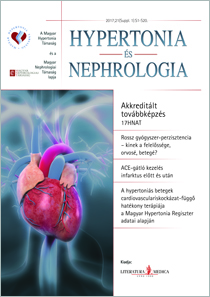The eLitMed.hu medical portal uses computer cookies for convenient operation. Detailed information can be found in the Cookie-policy.
Hypertension and nephrology - 2017;21(01 klsz)
Content
[Poor medication adherence - Whose responsibility? the physician and/or the patients?]
[Hypertension is one of the most frequent disease in Hungary and one of the most important cardiovascular risk factor. Treating to target, significantly lower the risk of coronary artery disease, stroke chronic renal disease and mortality too. In treating of hypertension after life style therapy drug treatment has an essential role. In essential hypertension patients need to treat to the end of their life. Therefore patient adherence plays a significant role in the success of the treatment. The complexity of medication regimen and characteristic of drug class, age and gender all have influence the patient adherence. In Hungary the one year persistence of ramipril/amlodipine fixed dose combination was 20 percent higher than ramipril amlodipine free combination and ramipril/amlodipine fixed dose combination was 25 percent higher than ramipril/hydrochlorothiazide fixed dose combination.]
[Angiotensin-converting enyzme inhibitors before and after myocardial infarction]
[In this review current knowledge related to the coronary atherosclerosis and angiotensin-enzym inhibitor is discussed. The earlier recognition to the effect of ACE inhibitors and ARBs to slow or reverse left ventricular remodelling is well known and accepted but the effect of these drugs on the atherosclerotic process itself may be aqual important. The focus should be now how to treat the early phase of coronary atherosclerosis, how to treat safety the hypertensive patient in the setting of coronary stenosis, how to treat the acute myocardial infarction’s patient with renal failure, and at least how to improve the long-time adherence in the primer and secunder prevention too.]
[Efficient, cardiovascular risk-dependent therapy of patients with hypertension according to the data from database of the Hungarian Hypertension Registry]
[Over 3.5 million people have hypertension in Hungary, although with only 40-45% of them have the target blood pressure of under 140/90 been reached thanks to the non-medication and medication therapies. The reason of this can be several folds as an improperly chosen blood pressure lowering therapy, not sufficient care, insufficient doctor-patient cooperation and the incompetent information of the patients. According to the Hungarian Hypertension Register’s database of 2015 it is confirmed that the reaching of target blood pressure significantly differs and in the case of the hypertension disease coincide with the morbidity and mortality differences of the regions. These regional differences can be explained with not only the social, cultural and economic dissimilarities, but with the diversity of the quality of the healthcare and the professional work. Analyzation of the biggest risk factors of hypertension as the diabetes, ischemic heart failure and chronic kidney disease showed that when all of them are extant, the reaching of the target blood pressure is only successful in the case of 26% of the male and 33% of the female’s patients. According to the Register it turned out that the leading cause of the unsuccessful reaching of the target blood pressure is the peripheral vascular disease in the case of female patients which is followed by in turn with the disorder of lipid metabolism, the disorder of uric acid metabolism and obesity. The leading cause in the case of male patients is lipid metabolism which is followed by in turn with smoking, alcohol abuse and peripheral vascular disease. According to the summed-up results, 88% of the patients received combined treatment with the medication suggested by the professional guidelines. The proportion responsible for the unsuccessful reaching of the target blood pressure can be explained by the insufficient patient concordance and adherence. Both patient information and the care involved in the doctor-patient relationship have to be corrected and improved. One possible solution is the transmission of some competence of the doctors to the well-trained assistants and nurses who have a decisive role in the risk assessment and the base medical examination. It is also important to draw the pharmacists in too to the care of patients with applying more telemedicinal methods. It can be concluded from the results that came from the processing of the Register’s database that the population-level knowledge is important and the continuation of the data entry into the Register is necessary.]
1.
Clinical Neuroscience
[Headache registry in Szeged: Experiences regarding to migraine patients]2.
Clinical Neuroscience
[The new target population of stroke awareness campaign: Kindergarten students ]3.
Clinical Neuroscience
Is there any difference in mortality rates of atrial fibrillation detected before or after ischemic stroke?4.
Clinical Neuroscience
Factors influencing the level of stigma in Parkinson’s disease in western Turkey5.
Clinical Neuroscience
[The effects of demographic and clinical factors on the severity of poststroke aphasia]1.
2.
Clinical Oncology
[Pancreatic cancer: ESMO Clinical Practice Guideline for diagnosis, treatment and follow-up]3.
Clinical Oncology
[Pharmacovigilance landscape – Lessons from the past and opportunities for future]4.
5.



